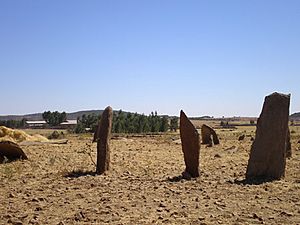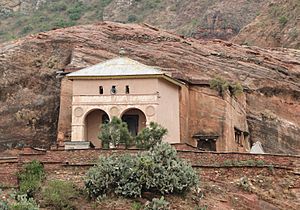Gudit facts for kids
Gudit (Ge'ez: ጉዲት) is an old name from Geʽez for a legendary queen. She is also known as Yodit in Tigray, Isato in Amharic, and Ga'wa in Ţilţal. According to old stories, she was a powerful queen who attacked the Kingdom of Aksum. She is said to have destroyed churches and important buildings. She also tried to get rid of the royal family. People still tell stories about her actions today.
Stories About Queen Gudit
It's hard to know everything about Gudit because the information is not complete. Some stories say she killed the emperor and ruled for 40 years. People in northern Ethiopia still talk about her violent deeds.
For example, a historian named Paul B. Henze visited a church called Abreha and Atsbeha. He saw that its beautiful ceiling was black with soot. The priest there explained that Gudit had filled the church with hay and set it on fire many centuries ago.
There is also a story that Gudit attacked and burned Debre Damo. This was a mountain fortress where the king kept his treasures and sometimes imprisoned male relatives. Some think this story might be similar to a later event when another fortress, Amba Geshen, was attacked. In Amharic, Gudit is called ʿEsato, which means "fire."
Another historian, James Bruce, wrote that Gudit overthrew King Dil Na'od. He also said that Mara Takla Haymanot was Gudit's cousin and became king after her family.
Sometimes, in oral traditions, Gudit is confused with a Muslim queen from the 16th century named Ga'ewa.
Who Was Queen Gudit?
Historians have different ideas about who Queen Gudit really was. One idea came from Carlo Conti Rossini. He thought she might have been the ruler of the Kingdom of Damot. This kingdom was once very powerful in southern Ethiopia. He believed she was connected to the Sidama people.
Later, another historian, Enrico Cerulli, found old Arabic writings. These documents mentioned a Muslim queen named Badit, daughter of Maya. She ruled in the tenth century under the Makhzumi dynasty.
Historian Tekeste Negash suggests that Gudit was a Cushitic queen. She might have been based near Lake Hayq in Wollo Province. He thinks there might have been a power struggle between Aksum and this queen. She might have had connections to traders from Yemen through the port of Zeila. Some Somali folk tales also mention a Harla queen named Arawelo. She ruled from Zeila and over much of Eastern Africa.
More recently, experts are less sure about Gudit's exact background. They think it's unlikely she was Jewish or connected to the Beta Israel people. Even though some Ethiopian stories say she was Jewish, they often say she converted to Judaism. The idea that she was a pagan queen from the south, who defeated a king, fits better with some historical clues. Christian stories might have changed her into a Jewish queen to fit their own religious ideas.
Historical Evidence of Gudit
Some historical writings suggest when Gudit's revolt happened. It was during the time of Pope Philotheos of Alexandria. This helps historians figure out a date around the year 960 for Gudit's actions.
An Arab historian named Ibn Hawqal wrote about this time. He said:
The country of the habasha has been ruled by a woman for many years now: she has killed the king of the habasha who was called Haḍani [which means king]. Until today she rules with complete independence in her own country.
This writing from a long time ago shows that a powerful queen was indeed ruling in the region.
Another historian mentioned that the king of Yemen sent a zebra as a gift in 969 or 970. He had received the zebra from the Queen of al-Habasha. This also points to a powerful female ruler in Ethiopia during that period.
See also
 In Spanish: Gudit para niños
In Spanish: Gudit para niños



